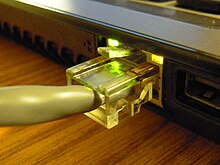

Ethernet (/ˈiːθərnɛt/ EE-thər-net) is a family of wired computer networking technologies commonly used in local area networks (LAN), metropolitan area networks (MAN) and wide area networks (WAN).[1] It was commercially introduced in 1980 and first standardized in 1983 as IEEE 802.3. Ethernet has since been refined to support higher bit rates, a greater number of nodes, and longer link distances, but retains much backward compatibility. Over time, Ethernet has largely replaced competing wired LAN technologies such as Token Ring, FDDI and ARCNET.
The original 10BASE5 Ethernet uses a thick coaxial cable as a shared medium. This was largely superseded by 10BASE2, which used a thinner and more flexible cable that was both cheaper and easier to use. More modern Ethernet variants use twisted pair and fiber optic links in conjunction with switches. Over the course of its history, Ethernet data transfer rates have been increased from the original 2.94 Mbit/s[2] to the latest 400 Gbit/s, with rates up to 1.6 Tbit/s under development. The Ethernet standards include several wiring and signaling variants of the OSI physical layer.
Systems communicating over Ethernet divide a stream of data into shorter pieces called frames. Each frame contains source and destination addresses, and error-checking data so that damaged frames can be detected and discarded; most often, higher-layer protocols trigger retransmission of lost frames. Per the OSI model, Ethernet provides services up to and including the data link layer.[3] The 48-bit MAC address was adopted by other IEEE 802 networking standards, including IEEE 802.11 (Wi-Fi), as well as by FDDI. EtherType values are also used in Subnetwork Access Protocol (SNAP) headers.
Ethernet is widely used in homes and industry, and interworks well with wireless Wi-Fi technologies. The Internet Protocol is commonly carried over Ethernet and so it is considered one of the key technologies that make up the Internet.
- ^ Ralph Santitoro (2003). "Metro Ethernet Services – A Technical Overview" (PDF). mef.net. Archived from the original (PDF) on December 22, 2018. Retrieved January 9, 2016.
- ^ Xerox (August 1976). "Alto: A Personal Computer System Hardware Manual" (PDF). Xerox. p. 37. Archived (PDF) from the original on September 4, 2017. Retrieved August 25, 2015.
- ^ Charles M. Kozierok (September 20, 2005). "Data Link Layer (Layer 2)". tcpipguide.com. Archived from the original on May 20, 2019. Retrieved January 9, 2016.